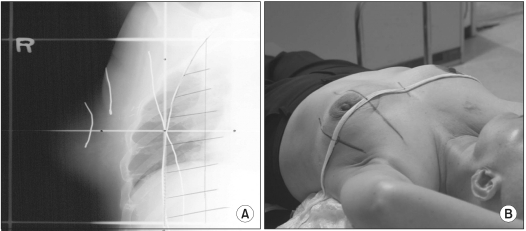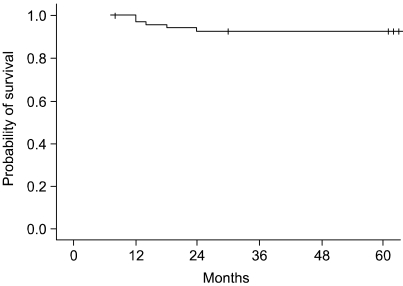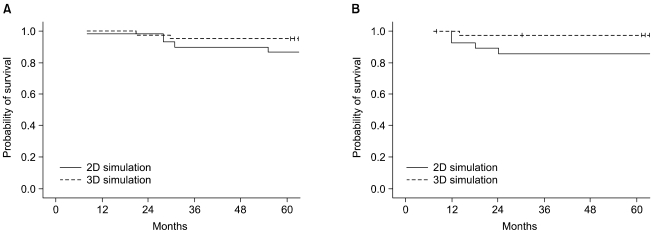Cancer Res Treat.
2006 Feb;38(1):40-47.
The Effect of Simulation on Recurrence after Breast-Conserving Surgery and Radiotherapy : Preliminary Results
- Affiliations
-
- 1Departments of Radiation Oncology, College of Medicine, The Catholic University of Korea, Seoul, Korea. sumic@catholic.ac.kr
- 2Departments of Surgery, College of Medicine, The Catholic University of Korea, Seoul, Korea.
Abstract
- PURPOSE
To evaluate the effect of the simulation method on recurrence among the patients who received radiotherapy after breast-conserving surgery (BCS) for early breast carcinoma.
METHODS
AND MATERIALS: Between 1995 and 2000, 70 patients with stage I-II breast carcinoma underwent breast-conserving surgery and adjuvant radiotherapy. Twenty nine patients (41.4%) were simulated with the 2D contour-based method (September 1995 to August 1997) and 41 patients (58.6%) were simulated with the 3D CT-based method (September 1997 to February 2000). To analyze the effect of the simulation method, the patient and treatment characteristics were compared.
RESULTS
The characteristics were similar for the patients between the 2D contour-based simulation group and the 3D CT-based simulation group. During a median follow-up period of 75 months, 4 (13.8%) of 29 patients who were treated with 2D simulation and 1 (2.4%) of 41 patients who were treated with 3D simulation group devel-oped treatment failure. The five-year survival rates were 89.2% and 95.1% between the 2D and 3D simulation groups (p=0.196). The five-year disease free survival (DFS) rates were 86.2% and 97.5% between the 2D and 3D simulation groups (p=0.0636). On univariate analysis, age > 40 (p= 0.0226) and the number of dissected axillary lymph node > or = 10 (p=0.0435) were independent predictors of improved 5-year DFS.
CONCLUSIONS
Although our data showed marginal significance for the DFS between the two groups, it is insufficient, due to the small number of patients in our study, to prove whether 3D CT-based simulation might improve the DFS and reduce the risk of recurrence when compared with 2D contour-based simulation. Further study is needed with a larger group of patients.
Keyword
MeSH Terms
Figure
Reference
-
1. Fisher B, Anderson S, Bryant J, Margolese RG, Deutsch M, Fisher ER, et al. Twenty-year follow-up of a randomized trial comparing total mastectomy, lumpectomy, and lumpectomy plus irradiation for the treatment of invasive breast cancer. N Engl J Med. 2002; 347:1233–1241. PMID: 12393820.
Article2. Veronesi U, Cascinelli N, Mariani L, Greco M, Saccozzi R, Luini A, et al. Twenty-year follow-up of a randomized study comparing breast conserving surgery with radical mastectomy for early breast cancer. N Engl J Med. 2002; 347:1227–1232. PMID: 12393819.3. Reed DR, Lindsley SK, Mann GN, Austin-Seymour M, Korssjoen T, Anderson BO, et al. Axillary lymph node with tangential breast irradiation. Int J Radiat Oncol Biol Phys. 2005; 61:358–364. PMID: 15667953.4. Krasin M, McCall A, King S, Olson M, Enami B. Evaluation of a standard breast tangent technique: a dose-volume analysis of tangential irradiation using three-dimensional tools. Int J Radiat Oncol Biol Phys. 2000; 47:327–333. PMID: 10802356.
Article5. Aird EG, Conway J. CT simulation for radiotherapy treatment planning. British J Radiol. 2002; 75:937–949.
Article6. AJCC American Joint Commitee on Cancer. Manual for staging of cancer. 2002. 6th ed. Philadelphia, JB: Lippincott;p. 223–236.7. Veronesi U, Luini A, Galimberti V, Zurrida S. Conservation approaches for the management of stage I/II carcinoma of the breast: Milan Cancer Institute trials. World J Surg. 1994; 18:70–75. PMID: 8197779.
Article8. Fisher B, Anderson S. National surgical adjuvant breast and bowel project. Conservative surgery for the management of invasive and noninvasive carcinoma of the breast: NSABP trials. World J Surg. 1994; 18:63–69. PMID: 8197778.
Article9. Carter CL, Allen C, Henson DE. Relation of tumor size, lymph node status, and survival in 24740 breast cancer cases. Cancer. 1989; 63:181–187. PMID: 2910416.
Article10. Yap KP, McCready DR, Narod S, Manchul LA, Trudeau M, Fyles A. Factors influencing arm and axillary symptoms after treatment for node negative breast carcinoma. Cancer. 2003; 97:1369–1375. PMID: 12627499.
Article11. Schijven MP, Vingerhoets AJ, Rutten HJ, Nieuwenhuijzen GA, Roumen RM, van Bussel ME, et al. Comparison of morbidity between axillary lymph node dissection and sentinel node biopsy. Eur J Surg Oncol. 2003; 29:341–350. PMID: 12711287.
Article12. Chetty U, Jack W, Prescott RJ, Tyler C, Rodger A. Management of the axilla in operable cancer treated by breast conservation: a randomized clinical trial. Br J Surg. 2000; 87:163–169. PMID: 10671921.13. Recht A, Houlihan MJ. Axillary lymph nodes and breast cancer. Cancer. 1995; 76:1491–1512. PMID: 8635050.14. Veronesi U, Paganelli G, Viale G, Luini A, Zurrida S, Galimberti V, et al. A randomized comparison of sentinel-node biopsy with routine axilllary dissection in breast cancer. N Engl J Med. 2003; 349:546–553. PMID: 12904519.15. Recht A, Pierce SM, Abner A, Vicini F, Osteen RT, Love SM, et al. Regional nodal failure after conservative surgery and radiotherapy for early stage breast carcinoma. J Clin Oncol. 1991; 9:988–996. PMID: 2033433.16. Ranger GS, Mokbel K. The evolving role of sentinel lymph node biopsy for breast cancer. Eur J Surg Oncol. 2003; 29:423–425. PMID: 12798744.17. Krag DN, Julian TB, Harlow SP, Weaver DL, Ashikaga T, Bryant J, et al. NSABP-32: Phase III, randomized trial comparing axillary resection with sentinal lymph node dissection: a description of the trial. Ann Surg Oncol. 2004; 11(Suppl 3):208S–210S. PMID: 15023753.
Article18. Kim JY, Chang ES. The recurrence of breast cancer after the breast conservation surgery. J Korean Cancer Assoc. 1994; 26:415–425.19. Hiraoka M, Mitsumori M, Okajima K, Nagata Y, Takahashi M, Nakata M, et al. Use of a CT simulator in radiotherapy treatment planning for breast conserving therapy. Radiother Oncol. 1994; 33:48–55. PMID: 7878209.
Article20. Dijkema IM, Hofman P, Raaijmarkers CP, Lagendijk JJ, Battermann JJ, Hilen B. Loco-regional conformal radiotherapy of the breast: delineation of the regional lymph node clinical target volumes in treatment position. Radiother Oncol. 2004; 71:287–295. PMID: 15172144.
Article21. Muren LP, Maurstad G, Hafslund R, Anker G, Dahl O. Cardiac and pulmonary doses and complication probabilities in standard and conformal tangential irradiation in conservative management of breast cancer. Radiother Oncol. 2002; 62:173–183. PMID: 11937244.
Article22. Bartelink H, Horiot JC, Poortmans P, Struikmans H, Bogaert WV, Barillot I, et al. Recurrence rates after treatment of breast cancer with standard radiotherapy with or without additional radiation. N Engl J Med. 2001; 345:1378–1387. PMID: 11794170.
Article23. Megale Costa LJ, Soares HP, Gaspar HA, Trujillo LG, Santi PX, Pereira RS, et al. Ratio between positive lymph nodes and total dissected axillaries lymph nodes as an independent prognostic factor for disease-free survival in patients with breast cancer. Am J Clin Oncol. 2004; 27:304–306. PMID: 15170153.
Article
- Full Text Links
- Actions
-
Cited
- CITED
-
- Close
- Share
- Similar articles
-
- Body Image and Physical suffering during Radiotherapy in Breast Cancer Patients Following Breast Conserving Operations
- Radiotherapy for Breast Cancer
- Validation of Radiation Volume by Analysis of Recurrence Pattern in Breast-conserving Treatment for Early Breast Cancer
- Comparison of Psychiatric Symptoms between Total Mastectomy and Breast Conserving Surgery in Breast Cancer Patients
- Follow-Up after Volume Replacement Using Acellular Dermal Matrix in Oncoplastic Breast-Conserving Surgery






